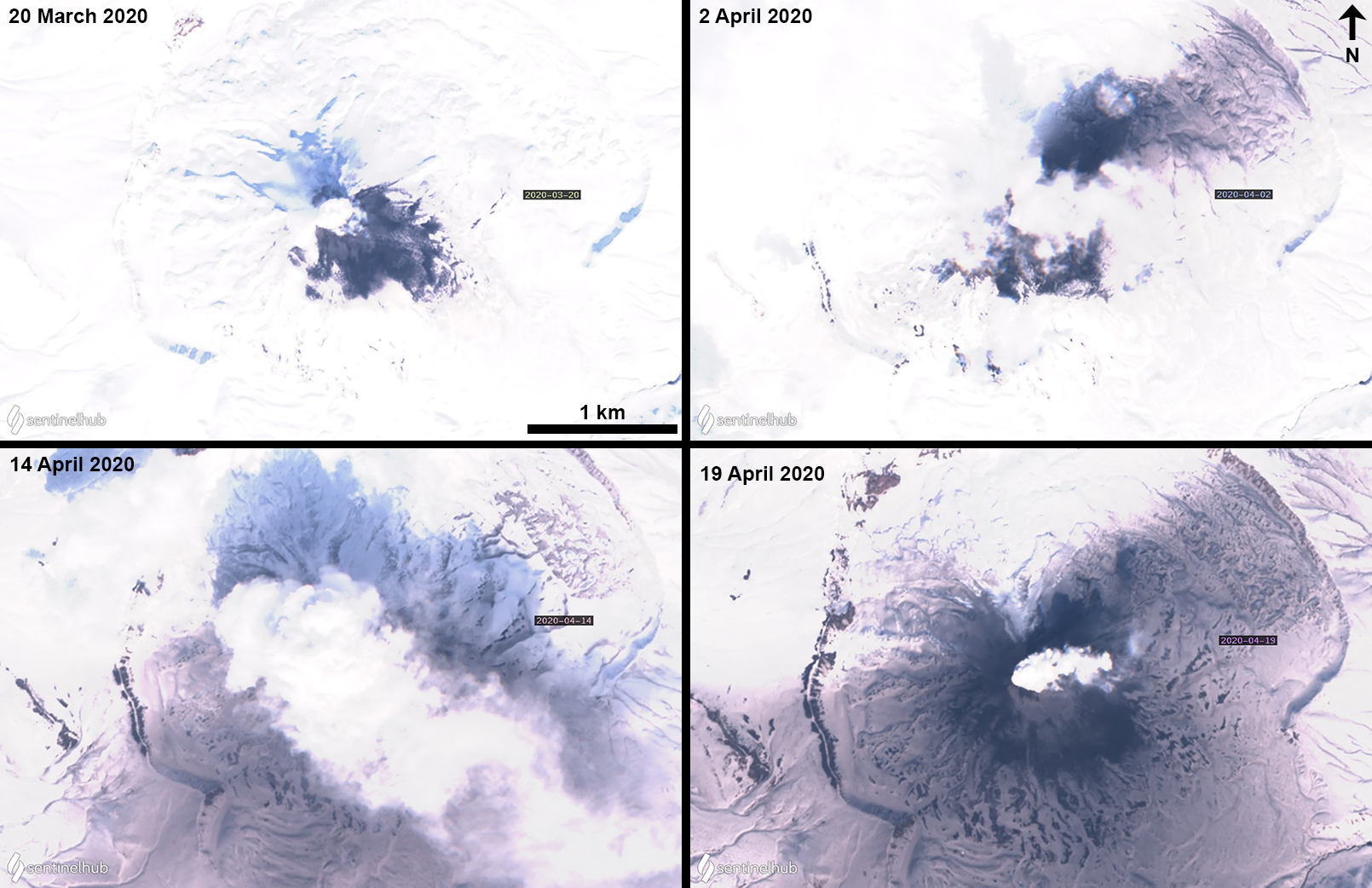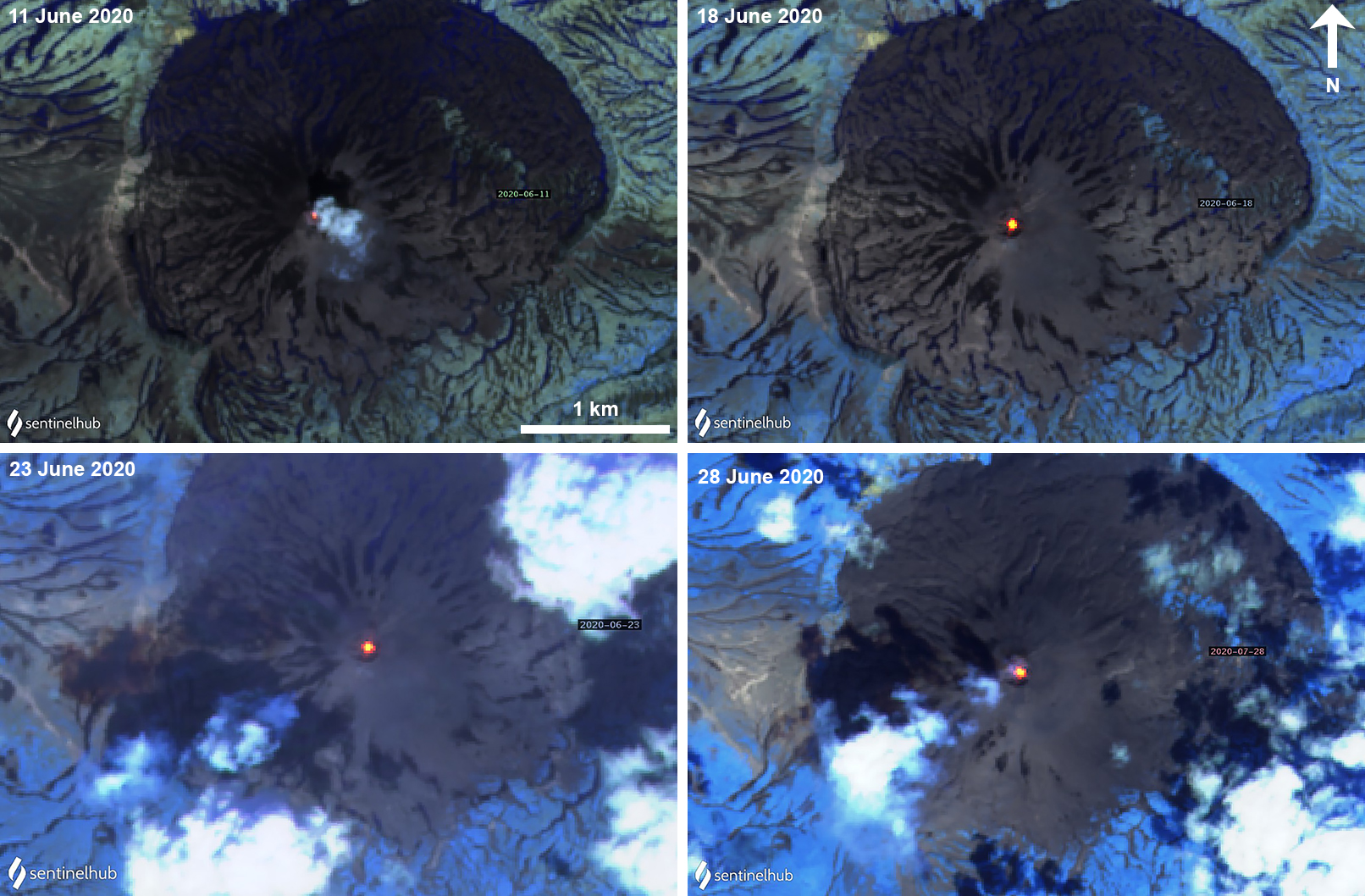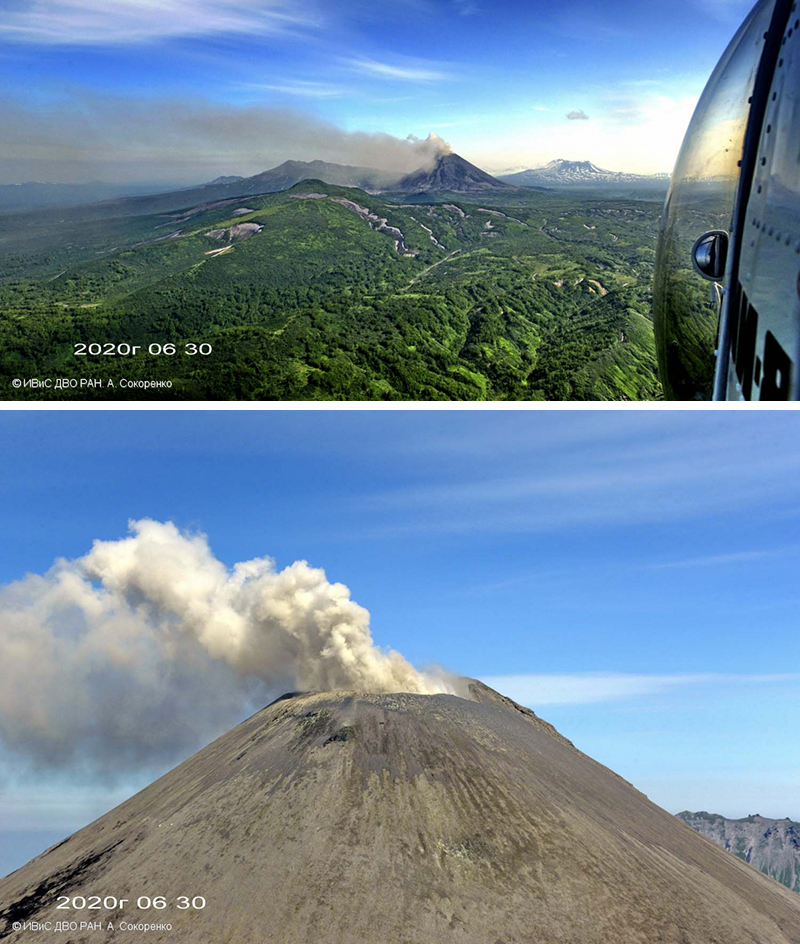Report on Karymsky (Russia) — October 2020
Bulletin of the Global Volcanism Network, vol. 45, no. 10 (October 2020)
Managing Editor: Edward Venzke.
Edited by Kadie L. Bennis.
Karymsky (Russia) New eruption during April-July 2020; ash explosions in October 2020
Please cite this report as:
Global Volcanism Program, 2020. Report on Karymsky (Russia) (Bennis, K.L., and Venzke, E., eds.). Bulletin of the Global Volcanism Network, 45:10. Smithsonian Institution. https://doi.org/10.5479/si.GVP.BGVN202010-300130
Karymsky
Russia
54.049°N, 159.443°E; summit elev. 1513 m
All times are local (unless otherwise noted)
Karymsky is an active volcano, part of Kamchatka’s eastern volcanic zone. Eruptive activity has been frequent since 1996 and has included ash explosions, gas-and-steam and ash emissions, and thermal anomalies. The most recent eruptive period ended in September 2019 (BGVN 44:11) with a new one beginning in April 2020. Both eruptions consisted of moderate explosive activity and ash plumes. This report updates information from November 2019 through October 2020, which describes a short-lived eruption from April to July and renewed activity in October. Information comes from daily, weekly, and special reports from the Kamchatka Volcanic Eruptions Response Team (KVERT), the Tokyo Volcanic Ash Advisory Center (VAAC), and satellite data.
Activity at Karymsky after November 2019 primarily consisted of moderate gas-and-steam emissions and rare weak thermal anomalies in the summit crater (on 2, 8, and 17 December 2019, according to KVERT). No thermal activity was reported during January through March 2020.
Over the weeks of late March to early April 2020, minor amounts of ash were present in gas-and-steam emissions that led to trace ashfall deposits on the snowy flanks and were visible in satellite imagery (figure 47). A weak thermal anomaly was observed in satellite imagery on 6 April. On 13 April the Tokyo VAAC reported an ash plume to 2.1 km altitude drifting SE. Gas-and-steam emissions containing some ash rose 2 km altitude on 17 April and drifted up to 80 km SE on both 17 and 21 April, accompanied by a weak thermal anomaly seen in satellite data. On 18 April the Tokyo VAAC released an advisory noting an ash plume at 1.5-2.1 km altitude drifting S.
KVERT reported intermittent thermal anomalies during May, along with moderate gas-and-steam emissions. On 10 May gas-and-steam plumes containing some ash drifted 77 km SE while ash plumes observed in HIMAWARI-8 satellite imagery rose to 2.7 km altitude. A dense plume drifting S resulted in large ash deposits covering all but the N flank of the volcano by 14 May, as observed in Sentinel-2 natural color satellite imagery (figure 48). KVERT reported that ash continued to be observed during 24-31 May, rising to a maximum altitude of 7 km on 27 May and extending in multiple directions. On 29 and 31 May explosions generated ash plumes that rose to 6 and 4 km altitude, respectively, and both extended up to 380 km SW, SE, and E. MIROVA (Middle InfraRed Observation of Volcanic Activity) analysis of MODIS satellite data shows a pulse in thermal activity within 5 km of the summit crater starting in late May, reflecting the renewed activity (figure 49). On 1 June another strong brown-gray ash plume was seen rising from Karymsky, drifting SE in satellite imagery, depositing large amounts of ash on all flanks (figure 48).
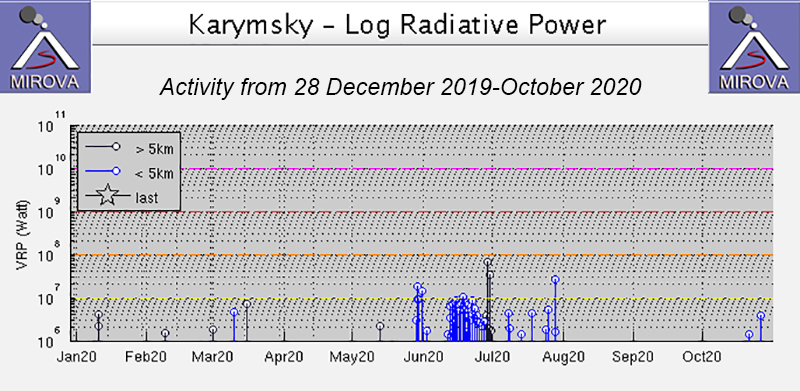 |
Figure 49. A pulse of thermal activity at Karymsky during late May through July 2020 was seen in the MIROVA graph (Log Radiative Power). Courtesy of MIROVA. |
Intermittent ash emissions and moderate explosive activity continued in June. During 1-4 June continuous ash plumes rose to a high of 4.6 km altitude and drifted up to 400 km generally E, according to KVERT and the Tokyo VAAC advisories. By 19 June, KVERT stated that possible Strombolian activity was occurring, accompanied by moderate gas-and-steam emissions and frequent thermal anomalies; Sentinel-2 thermal satellite imagery also showed a thermal anomaly in the crater (figure 50). Ash plumes and gas-and-steam plumes containing some amount of ash were seen drifting SW and NW on 30 June (figure 51).
Similar activity continued into July, which included possible Strombolian activity, moderate gas-and-steam emissions, and frequent thermal anomalies. On 14 July a gas-and-steam plume that contained some ash drifted 26 km SW (figure 52); the Tokyo VAAC advisory reported a continuous ash plume that rose 3 km altitude and drifted SW. During 27-30 July Strombolian and Vulcanian explosions generated ash plumes that rose 3-3.7 km altitude and extended 250 km SW and SE. The frequency of thermal anomalies seen in MIROVA decreased in July; the MODVOLC system detected one thermal hotspot on 28 July.
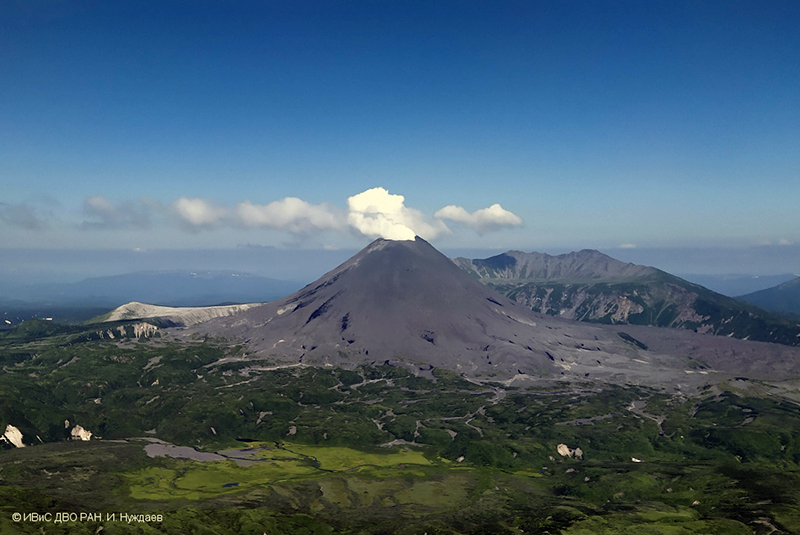 |
Figure 52. Fumarolic activity at Karymsky on 14 July 2020. Photo has been color corrected. Photo by Ivan Nuzhdaev; courtesy of IVS FEB RAS, KVERT. |
Activity decreased in August; thermal anomalies were reported on 5-7, 10, 18, and 21 August, the latter of which was last observed thermal anomaly, according to KVERT. Moderate gas-and-steam emissions continued to occur through the week of 3 September (figure 53). On 26 September, the Tokyo VAAC issued an advisory for a small ash plume that rose to 1.8 km altitude and extended SE.
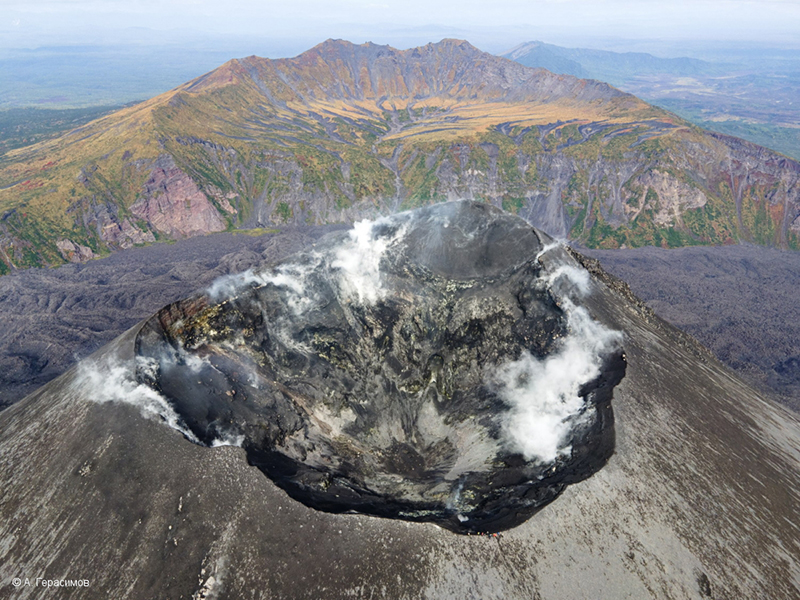 |
Figure 53. Minor gas-and-steam emissions rose from Karymsky on 2 September 2020. Photo by A. Gerasimov; courtesy of KVERT. |
After a brief period of little to no activity, Tokyo VAAC advisories on 10 and 11 October both reported small ash plumes that rose 1.8 km altitude and drifted SE. An ash plume on 17 October rose to 3.9 km altitude drifting E; on 20 October an ash plume drifted up to 50 km SE. KVERT reported that a new eruption began on 21 October; pilots observed explosions at 1430 that generated ash plumes up to 4 km altitude and extended 40 km SE (figure 54). Multiple ash plumes during that day rose up to 6.4 km altitude and drifted as far as 530 km SE, accompanied by a thermal anomaly. Frequent ash explosions continued through the end of the month, with the highest plume rising to an altitude of 6 km on 30 October. In late October two thermal anomalies were detected in MIROVA.
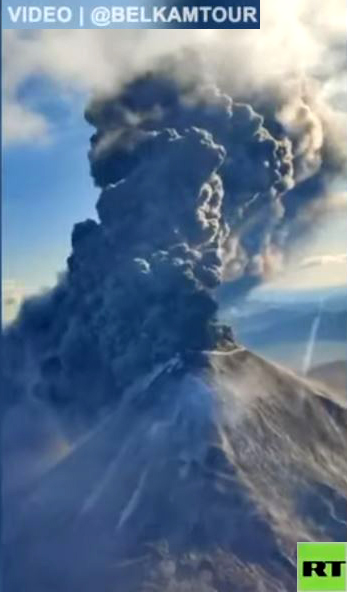 |
Figure 54. Frame from a video of the eruption at Karymsky on 21 October 2020. The ash plume is rising 6 km altitude. Video by Bel-Kam-Tour, courtesy of Russia Today. |
Geological Summary. Karymsky, the most active volcano of Kamchatka's eastern volcanic zone, is a symmetrical stratovolcano constructed within a 5-km-wide caldera that formed during the early Holocene. The caldera cuts the south side of the Pleistocene Dvor volcano and is located outside the north margin of the large mid-Pleistocene Polovinka caldera, which contains the smaller Akademia Nauk and Odnoboky calderas. Most seismicity preceding Karymsky eruptions originated beneath Akademia Nauk caldera, located immediately south. The caldera enclosing Karymsky formed about 7600-7700 radiocarbon years ago; construction of the stratovolcano began about 2000 years later. The latest eruptive period began about 500 years ago, following a 2300-year quiescence. Much of the cone is mantled by lava flows less than 200 years old. Historical eruptions have been vulcanian or vulcanian-strombolian with moderate explosive activity and occasional lava flows from the summit crater.
Information Contacts: Kamchatka Volcanic Eruptions Response Team (KVERT), Far Eastern Branch, Russian Academy of Sciences, 9 Piip Blvd., Petropavlovsk-Kamchatsky, 683006, Russia (URL: http://www.kscnet.ru/ivs/kvert/); Tokyo Volcanic Ash Advisory Center (VAAC), 1-3-4 Otemachi, Chiyoda-ku, Tokyo 100-8122, Japan (URL: http://ds.data.jma.go.jp/svd/vaac/data/); MIROVA (Middle InfraRed Observation of Volcanic Activity), a collaborative project between the Universities of Turin and Florence (Italy) supported by the Centre for Volcanic Risk of the Italian Civil Protection Department (URL: http://www.mirovaweb.it/); Hawai'i Institute of Geophysics and Planetology (HIGP) - MODVOLC Thermal Alerts System, School of Ocean and Earth Science and Technology (SOEST), Univ. of Hawai'i, 2525 Correa Road, Honolulu, HI 96822, USA (URL: http://modis.higp.hawaii.edu/); Sentinel Hub Playground (URL: https://www.sentinel-hub.com/explore/sentinel-playground); Bel-Kam-Tour, st. Elizova, 39 Paratunka Kamchatka Krai, 684000, Russia (URL: https://bel-kam-tour.business.site/); Russia Today (RT), Borovaya St., 3 bldg. 1, Moscow 111020 (URL: https://www.rt.com/).


